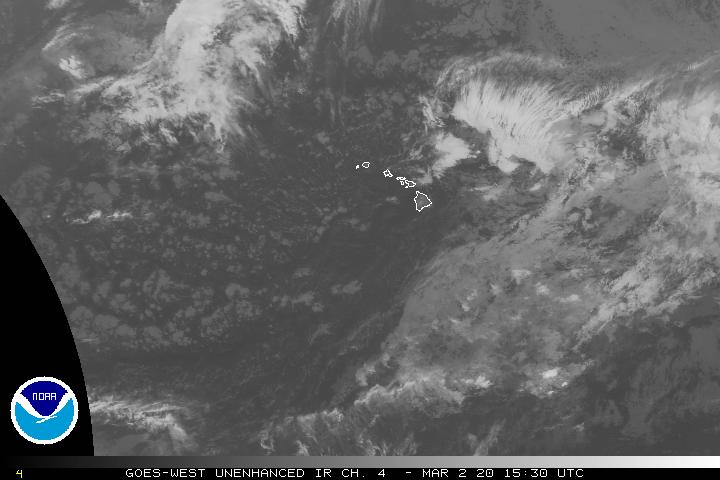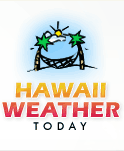Air Temperatures – The following high temperatures (F) were recorded across the state of Hawaii Thursday…along with the low temperatures Thursday:
74 – 64 Lihue, Kauai
81 – 70 Honolulu, Oahu
76 – 66 Molokai
80 – 66 Kahului AP, Maui
83 – 70 Kailua Kona
76 – 65 Hilo AP, Hawaii
Here are the latest 24-hour precipitation totals (inches) for each of the islands as of Thursday evening:
0.06 Kilohana, Kauai
0.03 Maunawili, Oahu
0.50 Molokai
0.02 Lanai
0.00 Kahoolawe
0.92 West Wailuaiki, Maui
1.83 Kawainui Stream, Big Island
The following numbers represent the strongest wind gusts (mph) as of Thursday evening:
37 Lihue, Kauai
51 Kuaokala, Oahu
30 Molokai
30 Lanai
50 Kahoolawe
31 Maalaea Bay, Maui
44 Kealokomo, Big Island
Hawaii’s Mountains – Here’s a link to the live webcam on the summit of our tallest mountain Mauna Kea (nearly 13,800 feet high) on the Big Island of Hawaii. Here’s the webcam for the Haleakala Crater on Maui. These webcams are available during the daylight hours here in the islands, and at night whenever there’s a big moon shining down. Also, at night you will be able to see the stars — and the sunrise and sunset too — depending upon weather conditions.
Aloha Paragraphs

Storms moving by west to east far north and northwest of Hawaii

Heavy clouds east

Clear to partly cloudy…cloudy areas locally

Showers locally…mostly windward – Looping image
High Surf Advisory…north and west shores of Kauai, Oahu, and Molokai, and north shores of Maui and the Big Island
Small Craft Advisory…large north-northwest swell and strong winds
Wind Advisory…All areas except Haleakala Crater
~~~Hawaii Weather Narrative ~~~
Broad Brush Overview: The ongoing bout of cool and dry conditions will prevail, along with gusty winds. The strong winds will taper off some tonight, while the cool conditions will linger into Friday. An upper level trough approaching from the northeast tonight will bring unsettled weather to portions of the state Friday into the weekend. The most unstable atmospherics will be over the eastern islands…and the waters to the northeast.
Details: Cold upper level temperatures will move in from the east, while at the same time an increase in low level moisture is expected. This unstable airmass will bring shower activity to the islands. The airmass will be unstable enough that a few thunderstorms could flare up. The best chance will be over the windward waters tonight through Saturday…and over portions of Maui and the Big Island Friday afternoon.
Looking Further Ahead: The next weather change of concern is a second upper level disturbance, which will approach the islands from the northwest early next week. The GFS and ECMWF models agree with the general weather pattern, although many of the details still need to be determined by future model runs.The weather may turn rather wet again towards next Tuesday through mid-week.
Here’s a wind profile of the Pacific Ocean – Closer view of the islands / Here’s the vog forecast animation / Here’s the latest weather map
Marine environment details: A High Surf Warning remains in effect for north and west facing shores of most islands with a High Surf Advisory (HSA) for north facing shores of the Big Island. The current northwest swell has peaked, but will still be quite large, before slowly subsiding through Saturday. Strengthening winds will cause rough surf on east facing shores tonight into the weekend. This surf may get large enough to require a HSA for east facing shores.
A Small Craft Advisory (SCA) is in effect for most waters, with a Gale Warning in effect for the Alenuihaha Channel. Seas are above the SCA threshold over areas exposed to the northwest swell with winds above the 25 knot SCA threshold in most areas. Northeast winds will peak as the pressure gradient between a high to the north and a trough to the east tightens. Winds will subside Friday into Saturday as the trough approaches from the east.
The approaching trough will bring increasing moisture and instability, so thunderstorms are possible as early as tonight over the windward waters of Maui and the Big Island, with the chance of lingering through Saturday.

Large surf along the north and west shores…lowering
World-wide Tropical Cyclone activity
>>> Here’s the latest PDC Weather Wall Presentation, covering Tropical Storm 32W (Kai-tak) just east of the Philippine Islands…and a tropical disturbance being referred to as Invest 97W in the western Pacific Ocean
![]()
>>> Atlantic Ocean:
>>> Caribbean Sea:
>>> Gulf of Mexico:
Here’s a satellite image of the Caribbean Sea…and the Gulf of Mexico
Here’s the link to the National Hurricane Center (NHC)
>>> Eastern Pacific:
Here’s a wide satellite image that covers the entire area between Mexico, out through the central Pacific…to the International Dateline.
Here’s the link to the National Hurricane Center (NHC)
>>> Central Pacific:
Here’s a link to the Central Pacific Hurricane Center (CPHC)
>>> Northwest Pacific Ocean:
Tropical Depression 32W (Kai-tak), here’s a graphical track map, a satellite image…and what the computer models are showing
>>> North and South Indian Oceans / Arabian Sea: No active tropical cyclones
Here’s a link to the Joint Typhoon Warning Center (JTWC)
Interesting: What Are Pyrocumulus Clouds? California Fires Spawn Eerie Formations – On Sunday (Dec.10), a massive gray cloud formed over Southern California’s Ventura and Santa Barbara counties, filling the sky with dark towers of smoke and shocking onlookers for miles around. The ominous cloud looked like an ash column from a volcanic eruption, but the culprit was a wildfire.
The cloud, created by the ongoing Thomas Fire that has scorched more than 230,500 acres (93,280 hectares) of Southern California, is an example of a pyrocumulus cloud — literally, a puffy cumulus cloud formed by the hot air and smoke released into the sky during wildfires and volcanic eruptions.
“Pyrocumulus clouds form when wildfires burn hot enough to generate very strong upward motion, which we call updrafts,” said Nick Nauslar, a research scientist for the Cooperative Institute for Mesoscale Meteorological Studies/Storm Prediction Center at the National Oceanic and Atmospheric Administration (NOAA).
These clouds tend to be gray, brown or black because of the smoke in the air, and can tower up to 5 miles high, according to NASA. But besides being terrifying, pyrocumulus clouds can develop dangerous weather systems of their own, and potentially lead to more and harder-to-tame wildfires.
Clouds of smoke and flame
Cumulus clouds take their name from the Latin word “cumulo,” meaning “heap” or “pile.” The fluffy, white cumulus clouds that commonly appear in the sky form when hot, moist air is warmed by Earth’s surface and begins to rise. The air cools as it rises, eventually condensing into water droplets that cling to airborne particles called condensation nuclei. As more droplets condense, they release more heat, creating a feedback loop of rising moisture that can result in the giant, puffy cloud heaps.
Pyrocumulus clouds form similarly, but in much more extreme circumstances of heating and condensation. While the hottest summer days might break triple-digit temperatures, a wildfire can rapidly warm the surrounding air to more than 1,470 degrees F, according to a report from the Natural History Museum of Utah.
The rising air condenses rapidly as it pours into the sky above the flames. Meanwhile, burning vegetation on the ground evaporates all of its moisture, compounding the condensation above. Particles of smoke already swirling through the air give water droplets even more condensation nuclei to grip onto, resulting in sudden, massive columns of moisture and smoke rolling into the sky over the blaze. From there, Nauslar said, another feedback loop may occur.
“As the air is forced upward, [it pulls] more oxygen into the bottom of the column,” Nauslar said. “This can help sustain and strengthen the fire. It will also result in stronger and less-predictable winds.”
Creating its own weather system
The hot, fast jets of rising air within pyrocumulus clouds tend to create a highly turbulent atmosphere, which can result in some unusual weather effects. If a cloud column builds high enough, for example, it can become a pyrocumulonimbus cloud — essentially, a fire-fueled thunderstorm cloud, NASA said.
In humid conditions, such clouds can actually produce rainstorms that put out the fire that created them, according to CNN. But in dry environments, like Southern California, rainfall is more likely to evaporate within the cloud itself, never reaching the ground. Even in the absence of rain, so-called “dry” lightning bolts can rip through the cloud or plunge to the surface, potentially sparking new fires, a National Weather Service report said. (The eerie phenomenon of volcanic lightning occurs under similar conditions.) The clouds pose less dramatic dangers, too.
“Pyrocumulus clouds can increase [wildfire] spotting, since you are lofting more embers higher into the atmosphere, which can increase the horizontal distance the embers travel,” Nauslar said. And if a large pyrocumulus column becomes too unstable, it may even collapse onto itself.
“A collapsing pyrocumulus cloud can have serious ramifications,” Nauslar said. “It would cause very strong and erratic winds at the surface and increase spotting as the embers reach the surface. This would be dangerous for anyone nearby.”












 Email Glenn James:
Email Glenn James:
Bill Johns Says:
Hi Glenn: Funny how poor our NOAA coverage is for the Maui community. I live in Maui Meadows and am aware of the fact that the radar on Molokai has a hard time reading what we can see out the window. Most of the afternoon here the wi d has been steady at 40+mph and there have been rain squalls that appear to go directly over central Kihei….The fine misty kine that stings as it is going sideways. The big laugh comes from the fact that the nexrad Molokai was off line this AM for maintenance…Maybe we could get a rain gauge working again by the new high school.
~~~ Hi Bill, thanks for letting us know about the lack of coverage over Kihei, I hope that things improve in this regard.
Aloha, Glenn
David Hume Says:
Clear skies again but last nights meteor shower was only a fraction of what happened the night before. The peak was Tuesday night not Wednesday night. Aloha David.
~~~ Thanks David, I got up and went outside for this shower, and found it uderwhelming.
I wish I would have known about the peak being Tuesday, I did however see a great meteor early in the evening Wednesday, and only 8 unspectacular shooters from 200am until 230am Thursday morning.
Aloha, Glenn